In a significant update aimed at enhancing productivity management, Apple has introduced long-awaited integration between its Calendar and Reminders apps. With the release of iOS 18 and macOS Sequoia, currently available in Developer beta, users can now view and manage reminders directly within the Calendar app. This integration aims to eliminate the need for users to switch between apps for scheduling and task management purposes.
The longstanding division between Apple’s Calendar and Reminders apps has been a point of contention for users accustomed to seamless integration across other productivity platforms. Previously, events and meetings were managed in the Calendar app, while tasks requiring completion were housed separately in the Reminders app. This separation often led to a disjointed user experience, requiring manual synchronisation and navigation between apps.
How It Works
Apple’s implementation of reminders in the Calendar app is straightforward. Users simply create reminders within the Reminders app, specifying a due date and time. These reminders automatically appear within the Calendar app, alongside scheduled events. Each reminder retains its assigned list colour, enabling quick visual identification and organisation.
The integration spans both day and month views within the Calendar app, ensuring reminders are visible at a glance across different time frames. Users can adjust reminder timings directly within the Calendar interface, mirroring the flexibility already available for events. Any changes made in Calendar synchronise instantly with the Reminders app, ensuring consistent updates across platforms.
Conversely, users can create reminders from within the Calendar app itself, though this feature currently offers a slightly less polished experience compared to using the Reminders app directly.
Third-Party Options
Despite Apple’s progress in integration, alternative third-party apps offer features that may appeal to certain users. Apps like ReminderCal import reminders into the Calendar app as events, providing customisation options not yet available in Apple’s native integration. However, these third-party solutions often face sync and connectivity challenges, which Apple’s seamless ecosystem aims to avoid.
For users seeking a unified interface for managing tasks and events, apps like Structured present an alternative. Structured allows users to manage tasks and events seamlessly, a capability Apple’s current integration lacks. While Apple’s advancements in iOS 18 represent a significant step forward, the persistence of separate apps for calendars and reminders highlights ongoing opportunities for innovation in productivity tools.
Future Developments
Looking ahead, Apple’s integration of reminders into the Calendar app sets a precedent for improved user convenience and productivity. As Apple refines this feature through beta testing and updates, users can expect enhanced functionality and interface improvements. Future developments may include expanded customisation options, improved Siri integration for voice-controlled task management, and greater compatibility with third-party productivity tools.
In conclusion, Apple’s latest update marks a notable evolution in its ecosystem, addressing user feedback for integrated task and event management. While third-party options continue to cater to specific preferences, Apple’s native integration promises a seamless experience for millions of iOS and macOS users worldwide. As technology advances, Apple remains committed to enhancing productivity tools that empower users to manage their schedules effortlessly.


